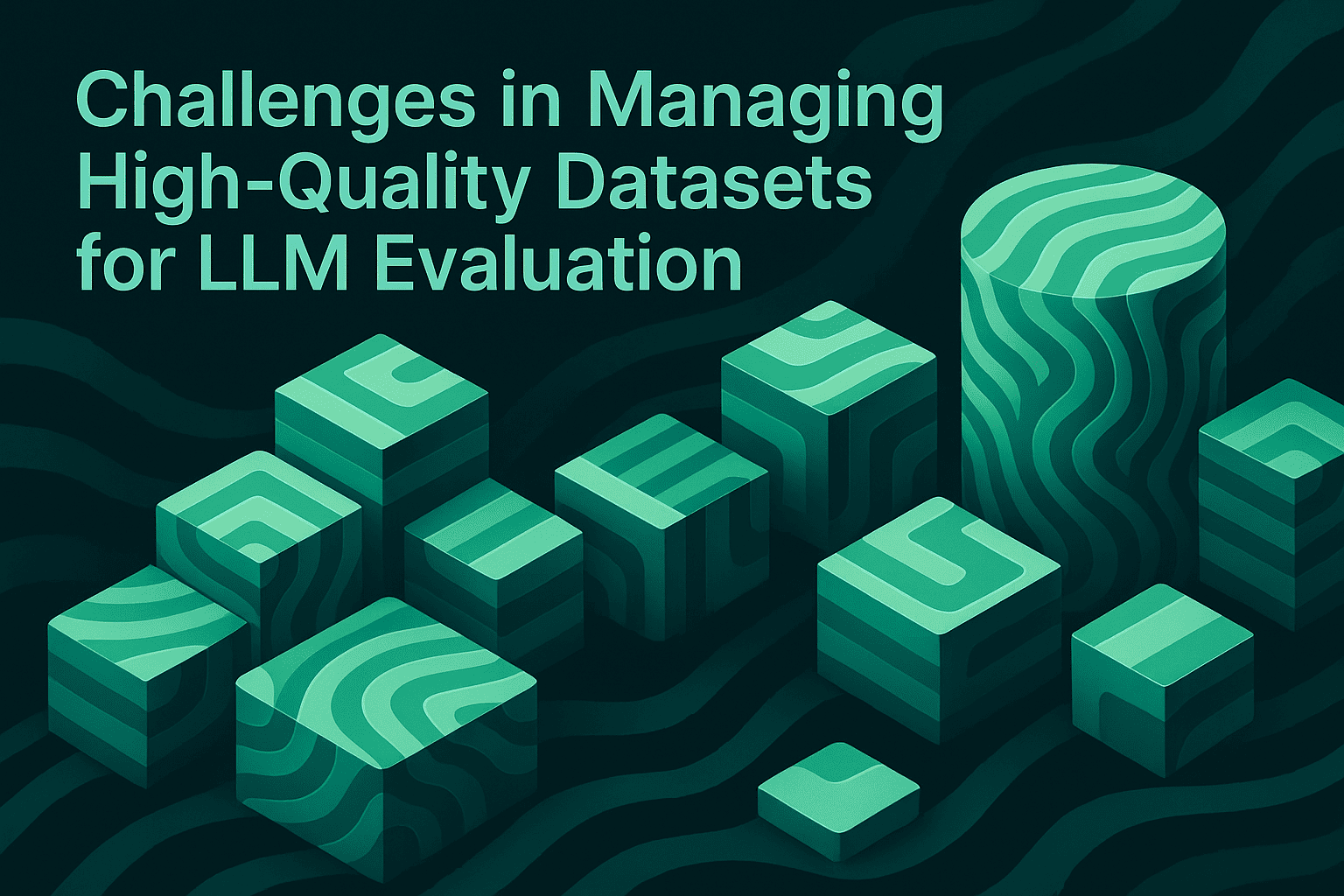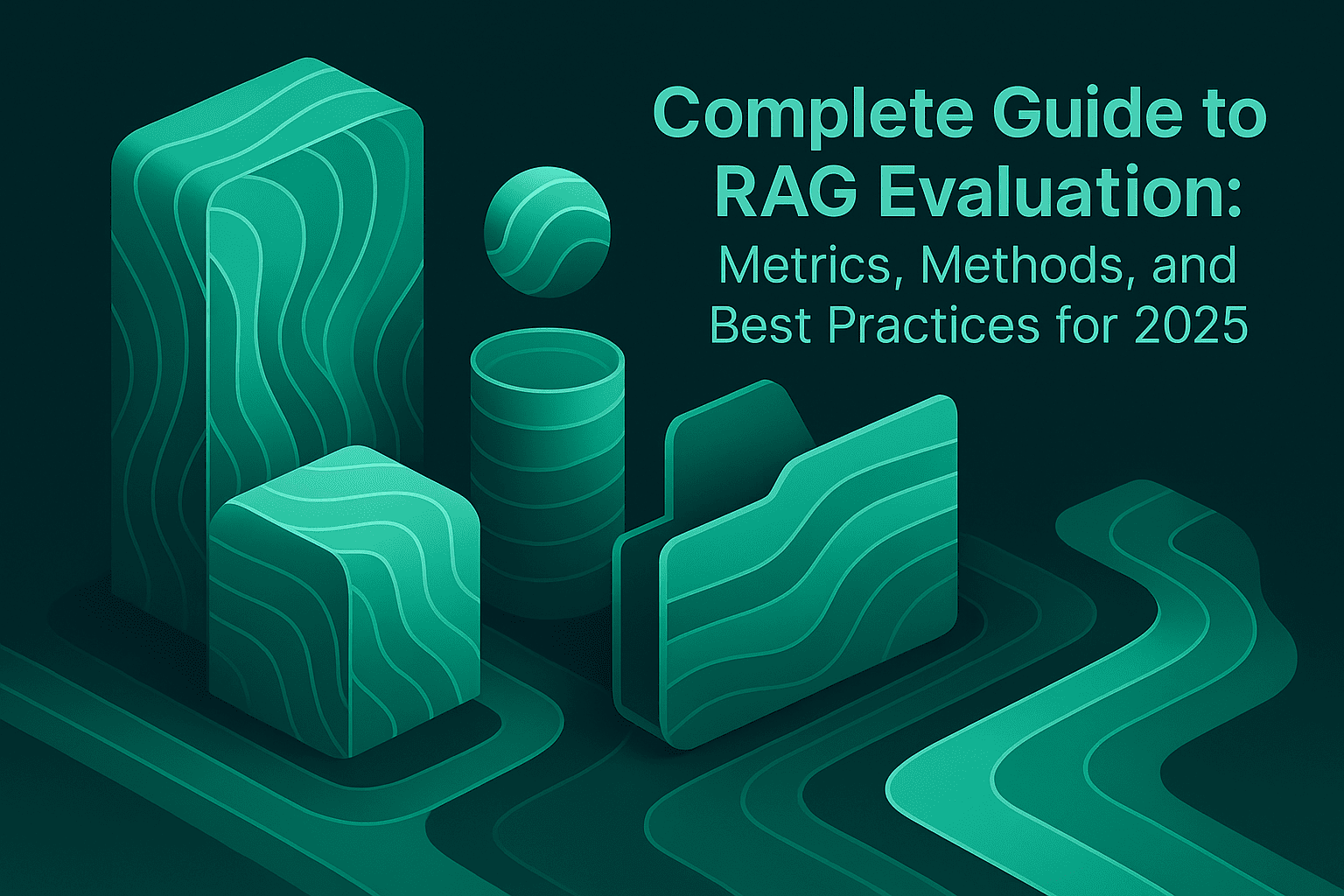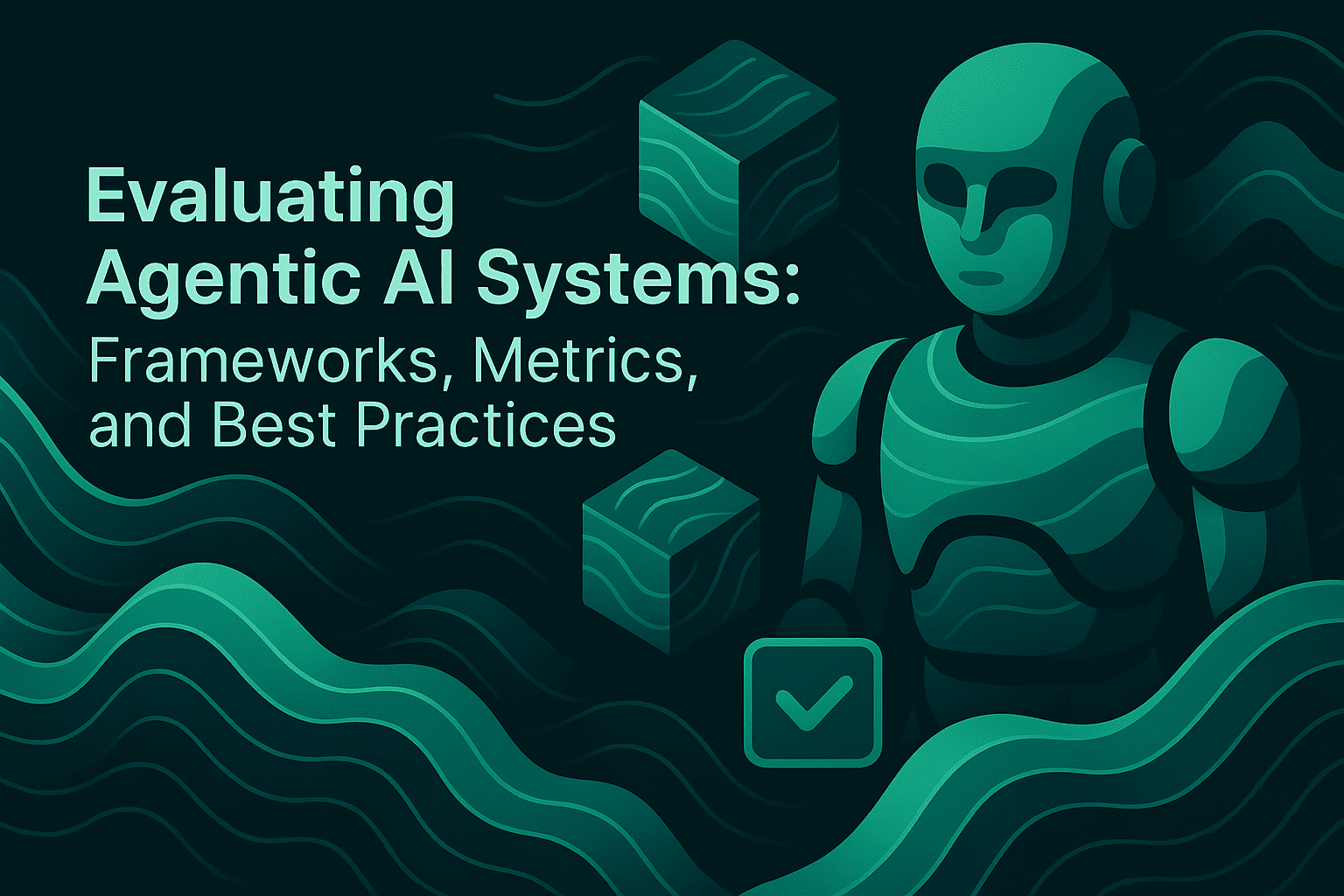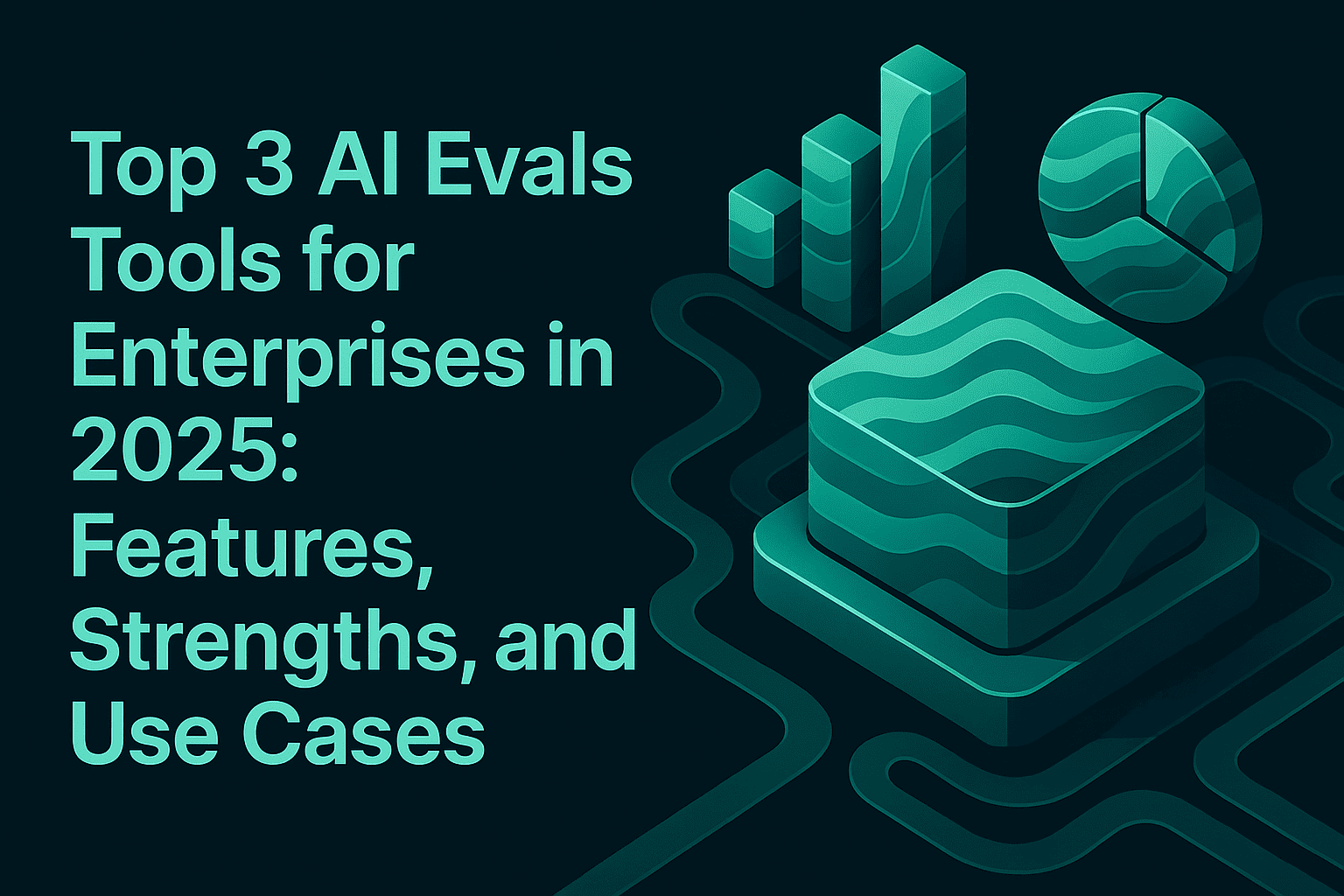Challenges in Managing High-Quality Datasets for LLM Evaluation

TL;DR
Managing high-quality datasets for LLM evaluation presents significant challenges that directly impact model performance and reliability. Research shows that models trained with poor data quality can experience a precision drop from 89% to 72%, demonstrating the critical importance of data curation. Organizations face hurdles including dataset scalability issues, annotation costs, maintaining data quality standards, handling multi-modal content, and ensuring continuous dataset evolution. This article explores these challenges and provides actionable solutions through proper evaluation frameworks, automated quality checks, and systematic dataset management practices that enable reliable LLM deployment.
The Critical Role of Dataset Quality in LLM Performance
Dataset quality serves as the foundation for successful LLM applications. The principle of "garbage in, garbage out" applies directly to language models, where poor-quality training and evaluation data lead to unreliable model behavior, biased outputs, and inaccurate predictions.
Recent research from Google and academic institutions reveals that data practitioners are shifting from bottom-up to top-down data understanding approaches. Instead of manually building insights from granular analysis, teams now leverage LLMs to generate high-level summaries upfront, diving deeper into details only when needed. This evolution demands more rigorous dataset management practices.
The emergence of multi-tiered dataset hierarchies has become critical for LLM development. Organizations now work with:
- Golden datasets: High-quality datasets for model training and evaluation
- Silver datasets: Primarily LLM-generated labels that supplement traditional data
- Super-golden datasets: Exceptionally high-quality datasets curated by expert teams for benchmarking LLMs against human performance
Studies demonstrate that models fine-tuned on high-quality medium-sized datasets (approximately 10,000 data points) can achieve performance comparable to or better than larger LLMs but with dramatically smaller resource requirements, faster inference, and reduced costs. This shift emphasizes quality over quantity in dataset management.
Understanding the Dataset Management Landscape
Effective dataset management for LLM evaluation requires comprehensive infrastructure that supports the entire data lifecycle.
The data management ecosystem encompasses several critical components:
Pre-training corpora provide the foundation for model knowledge, requiring massive scale and diverse content sources. Organizations must balance comprehensiveness with computational feasibility while ensuring data provenance and licensing compliance.
Instruction fine-tuning datasets enable models to follow specific task patterns and user intents. These datasets demand precise annotation, clear instructions, and representative examples that cover edge cases and variations.
Evaluation datasets serve as benchmarks for measuring model quality across multiple dimensions. These require ground truth labels, diverse test scenarios, and metrics aligned with real-world performance indicators.
Maxim's Data Engine provides seamless data management capabilities that enable teams to curate and enrich multi-modal datasets easily. The platform supports importing datasets including images with a few clicks, continuously curating and evolving datasets from production data, and enriching data using in-house or Maxim-managed data labeling and feedback.
Scale and Resource Management Challenges
Dataset scale presents one of the most significant challenges in LLM evaluation. Large datasets lead to better model performance, but they come with substantial costs regarding storage repositories, data refining, and annotation infrastructure.
Storage and infrastructure costs scale linearly with dataset size. Organizations working with multi-modal content face exponential growth in storage requirements. A single high-resolution image dataset can consume terabytes of space, while video content for evaluation multiplies storage needs by orders of magnitude.
Annotation costs represent another major bottleneck. Annotating data—labeling it so models can comprehend it—can be exceptionally costly and labor-intensive. Teams may need to hire specialized annotators or invest in annotation tools that still require substantial oversight. The cost-benefit analysis becomes critical when deciding between dataset size and annotation quality.
Computational requirements for dataset processing and evaluation grow exponentially. Processing large evaluation datasets requires distributed computing infrastructure, efficient data pipelines, and optimized storage solutions. Organizations must balance evaluation comprehensiveness with computational budgets.
Maxim's dataset management capabilities address these scalability challenges by providing efficient workflows for dataset curation, version control, and automated quality checks that reduce manual overhead while maintaining high standards.
Data Quality and Consistency Issues
Maintaining consistent data quality across evaluation datasets presents multifaceted challenges that directly impact model reliability and evaluation accuracy.
Noise and inconsistencies in datasets manifest in various forms. Research demonstrates that introducing errors into fine-tuning data shows a significant drop in prediction quality, with precision declining from 89% down to 72% as noise increases. These errors include incorrect labels, missing values, biased information, or noisy inputs that compromise model performance.
Detection of low-quality data remains challenging without automated solutions. Bad data hampers not only LLM fine-tuning but evaluation as well. Problematic data points include low-quality responses, incomplete or vague prompts, toxic language, personally identifiable information, informal writing, and poor grammar or spelling.
Common data quality issues include:
- Incorrect or inconsistent labels across dataset samples
- Missing or incomplete attribute values that affect evaluation completeness
- Duplicate entries that skew evaluation metrics and create false performance indicators
- Format inconsistencies that complicate data processing and model input preparation
- Temporal drift where dataset characteristics diverge from current production data
Bias and representation challenges require careful attention. Datasets may underrepresent certain demographics, languages, or use cases, leading to models that perform poorly on underrepresented groups. Researchers discovered that AI-powered automated captioning features perform less accurately with certain accents, highlighting the importance of diverse, representative datasets.
Maxim's evaluation framework provides comprehensive quality assessment through pre-built evaluators that detect these issues automatically. The platform offers AI-driven evaluators, statistical metrics, and programmatic evaluators that catch data quality problems before they impact model performance.
Multi-Modal Dataset Complexity
Modern LLM applications increasingly require multi-modal datasets that combine text, images, audio, and structured data. Managing these diverse data types introduces unique challenges that complicate evaluation workflows.
Format standardization across modalities requires consistent preprocessing pipelines. Images need resizing, normalization, and format conversion. Audio requires sampling rate standardization, noise reduction, and feature extraction. Text demands tokenization, encoding, and context windowing. Coordinating these preprocessing steps while maintaining data quality proves challenging.
Annotation complexity multiplies with multi-modal content. Annotating image-text pairs requires understanding both visual elements and textual descriptions. Video annotations demand temporal alignment with transcripts or descriptions. Audio-text alignment requires precise timing synchronization. Each modality adds annotation dimensions that increase costs and complexity.
Storage and retrieval challenges escalate with multi-modal datasets. Different data types require different storage solutions—relational databases for structured data, object storage for images and videos, vector databases for embeddings. Efficient retrieval systems must coordinate across these storage layers while maintaining performance.
Maxim's platform supports multimodal data seamlessly, allowing input queries, images, expected outputs, and tool calls to be integrated into testing workflows. This unified approach simplifies multi-modal evaluation while maintaining data quality standards.
Dataset Versioning and Evolution Management
LLM evaluation datasets require continuous evolution to remain relevant and effective. Managing dataset versions while maintaining reproducibility and traceability presents significant operational challenges.
Version control requirements for datasets differ fundamentally from code versioning. Dataset changes involve data additions, deletions, modifications, and schema updates. Each change potentially affects evaluation results, requiring careful tracking and documentation of dataset evolution.
Reproducibility challenges arise when evaluation results depend on specific dataset versions. Organizations must maintain historical dataset versions to reproduce evaluation results, compare model performance across time, and validate regression testing. This requirement multiplies storage costs and complicates data management infrastructure.
Dataset drift occurs when production data characteristics diverge from evaluation datasets. Models evaluated on outdated datasets may perform poorly in production environments where data distributions, user behaviors, or content types have evolved. Detecting and quantifying dataset drift requires systematic monitoring and comparison.
Continuous dataset curation becomes essential for maintaining evaluation relevance. Organizations must continuously curate and evolve datasets from production data, incorporating new edge cases, updating labels based on model performance, and removing obsolete or irrelevant samples.
Maxim's dynamic datasets adapt over time, updating automatically based on user feedback and metadata. The platform provides robust versioning capabilities that enable teams to track dataset evolution while maintaining reproducibility for evaluation experiments.
Evaluation Metric Selection and Implementation
Selecting appropriate evaluation metrics for LLM datasets requires deep understanding of application requirements, model capabilities, and business objectives. The wrong metrics lead to optimizing for irrelevant performance indicators while missing critical quality issues.
Metric alignment with objectives proves challenging when business goals don't map directly to standard metrics. Customer satisfaction may depend on response tone, helpfulness, and accuracy—qualities that require custom evaluation approaches beyond simple accuracy or F1 scores.
Trade-offs between metric types require careful consideration:
- Reference-based metrics (BLEU, ROUGE, exact match) compare outputs against expected results, providing reliable evaluation but requiring extensive manual curation
- Reference-free metrics (coherence, fluency, relevance) evaluate outputs independently but may show more variability in scores
- Task-specific metrics (task success, tool selection accuracy, step completion) measure application-specific performance but require custom implementation
Research indicates that reference-based metrics are more reliable because they have stricter evaluation criteria, though they require more effort to curate proper reference datasets. Reference-free metrics have looser rubrics, making LLM-computed scores more likely to fluctuate for the same test cases.
Evaluation at multiple levels becomes necessary for complex applications. Node-level evaluation assesses individual components, conversation-level evaluation measures end-to-end performance, and trajectory evaluation examines the reasoning paths models take to reach conclusions.
Maxim's evaluator library provides comprehensive metric coverage including AI evaluators for faithfulness, context relevance, task success, statistical evaluators, and programmatic evaluators. Teams can also create custom evaluators tailored to specific application needs.
Production-Evaluation Gap and Dataset Representativeness
The gap between evaluation datasets and production environments creates one of the most critical challenges in LLM deployment. Models that perform well on curated evaluation datasets may fail in production due to distribution shifts, unexpected user inputs, or edge cases not represented in evaluation data.
Distribution shift occurs when production data characteristics differ from evaluation datasets. User query patterns evolve over time, new use cases emerge, and content distributions change. Models optimized for static evaluation datasets may not generalize to these dynamic production conditions.
Edge case coverage requires systematic identification and inclusion of rare but critical scenarios. Production logs reveal edge cases that evaluation datasets miss—unusual query formulations, unexpected error conditions, adversarial inputs, or novel use cases not anticipated during dataset creation.
User behavior modeling proves difficult to capture in static datasets. Real users exhibit diverse interaction patterns, make unexpected requests, provide ambiguous inputs, and engage in multi-turn conversations that deviate from scripted evaluation scenarios.
Continuous dataset enrichment from production data addresses representativeness challenges. Organizations can curate datasets directly from production logs, incorporating real user queries, edge cases that caused failures, and interactions that revealed model limitations.
Maxim's observability suite enables teams to track, debug, and resolve live quality issues with real-time alerts. The platform facilitates creating datasets from production data, allowing teams to bridge the evaluation-production gap systematically.
Human-in-the-Loop Evaluation Challenges
Human evaluation remains essential for assessing subjective qualities that automated metrics cannot capture. However, managing human evaluation introduces operational challenges, consistency issues, and scalability limitations.
Annotator agreement and consistency prove difficult to maintain across large evaluation efforts. Different annotators may interpret evaluation criteria differently, leading to inconsistent labels that undermine dataset quality. Measuring inter-annotator agreement through metrics like Cohen's kappa helps identify consistency issues but doesn't solve them.
Evaluation criteria ambiguity creates confusion when instructions lack precision. Subjective qualities like "helpfulness," "tone," or "clarity" require concrete examples and detailed rubrics. Without clear guidelines, annotators make inconsistent judgments that reduce evaluation reliability.
Scale and cost limitations constrain human evaluation coverage. Manual annotation for large datasets becomes prohibitively expensive and time-consuming. Organizations must strategically select samples for human evaluation, balancing coverage with resource constraints.
Annotation quality assurance requires systematic verification processes. Spot-checking random samples, measuring annotator accuracy against gold-standard examples, and providing ongoing training help maintain annotation quality but add overhead to evaluation workflows.
Maxim's human annotation capabilities enable teams to define and conduct human evaluations for last-mile quality checks and nuanced assessments. The platform supports setting up human annotation on production logs, combining automated and manual evaluation approaches for comprehensive quality assessment.
Dataset Security, Privacy, and Compliance
Managing evaluation datasets requires careful attention to security, privacy, and regulatory compliance. Datasets often contain sensitive information that demands protection while remaining accessible for evaluation purposes.
Personally identifiable information (PII) in datasets creates significant risks. Customer names, email addresses, phone numbers, financial information, and health records require careful handling to comply with regulations like GDPR and HIPAA. PII detection evaluators help identify sensitive information before it compromises compliance.
Data anonymization challenges require balancing privacy protection with dataset utility. Removing or masking PII may reduce dataset representativeness or remove contextual information that models need for accurate evaluation. Synthetic data generation offers alternatives but introduces questions about evaluation validity.
Access control and governance become critical for sensitive datasets. Organizations must implement role-based access controls, audit logging, and data lineage tracking to ensure appropriate dataset usage. Compliance requirements may mandate specific retention periods, deletion procedures, and usage restrictions.
Regulatory compliance varies across jurisdictions and industries. Healthcare applications must comply with HIPAA, financial services with PCI DSS, and European operations with GDPR. Each regulation imposes specific requirements on data handling, storage, and processing that affect dataset management practices.
Maxim's enterprise-grade security features provide robust access controls and compliance support for sensitive datasets. The platform enables organizations to maintain evaluation quality while meeting stringent security and privacy requirements.
Automated Solutions for Dataset Quality Management
Automation provides critical leverage for managing dataset quality at scale. Modern platforms combine AI-powered analysis, statistical methods, and programmatic checks to identify and remediate data quality issues efficiently.
Automated quality detection employs multiple techniques to identify problematic data. AI evaluators analyze semantic coherence, factual accuracy, and task-specific quality metrics. Statistical methods detect outliers, distribution shifts, and anomalies. Programmatic checks validate format compliance, schema adherence, and data integrity constraints.
Continuous evaluation pipelines enable systematic quality monitoring. Automated evaluations can run on production logs based on custom rules, providing ongoing quality assessment without manual intervention. These pipelines catch quality degradation early, before it affects model performance.
Alert and notification systems keep teams informed about quality issues. Setting up alerts and notifications enables proactive responses to quality problems. Teams can configure thresholds for various metrics and receive notifications when datasets fall below acceptable quality standards.
Synthetic data generation augments datasets systematically. AI-powered generation creates additional evaluation examples that cover edge cases, increase dataset diversity, and improve evaluation coverage. Synthetic data helps address class imbalance, underrepresented scenarios, and data scarcity challenges.
Maxim's automation capabilities streamline dataset quality management through comprehensive evaluator libraries, automated evaluation pipelines, and intelligent data curation workflows. The platform enables teams to maintain high dataset quality while scaling evaluation efforts efficiently.
Conclusion
Managing high-quality datasets for LLM evaluation presents multifaceted challenges that directly impact model reliability, deployment success, and business outcomes. Organizations face difficulties with scale and resource management, data quality consistency, multi-modal complexity, versioning, metric selection, production-evaluation gaps, human evaluation, and security compliance.
Success requires systematic approaches that combine automated quality checks, continuous dataset evolution, comprehensive evaluation frameworks, and human oversight. Platforms like Maxim AI provide integrated solutions that address these challenges through end-to-end dataset management, flexible evaluation capabilities, and robust observability infrastructure.
The shift toward quality over quantity in dataset management represents a fundamental change in LLM development practices. Organizations that invest in high-quality, well-managed evaluation datasets position themselves for reliable AI deployment, better model performance, and sustainable competitive advantages in AI-driven markets.
Start optimizing your LLM evaluation datasets with Maxim's comprehensive platform and experience faster, more reliable AI development through better data management.


